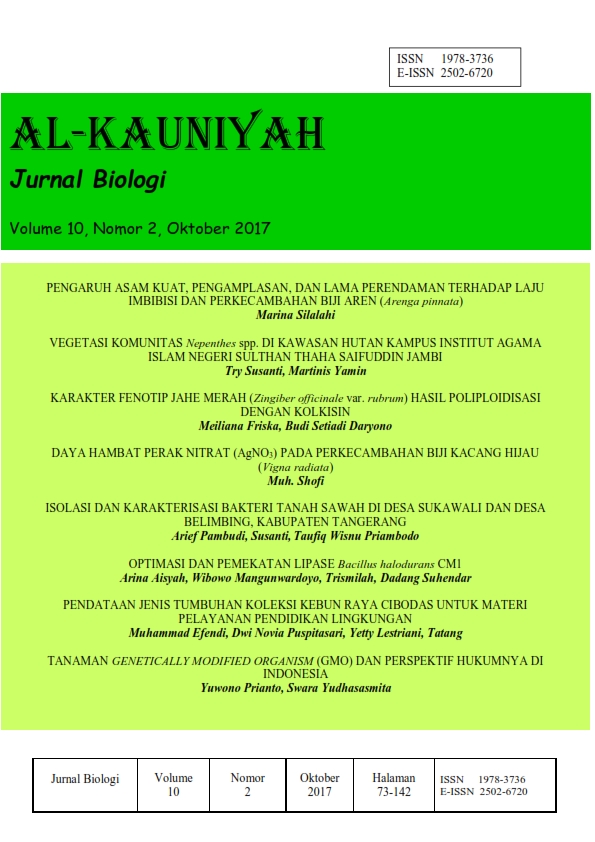Vegetasi Komunitas Nepenthes spp. di Kawasan Hutan Kampus Institut Agama Islam Negeri Sulthan Thaha Saifuddin Jambi
DOI:
https://doi.org/10.15408/kauniyah.v10i2.4789Keywords:
Kata kunci, Jambi, Komunitas, Kampus IAIN STS, Nepenthes spp., Keywords, community, campus of IAIN STSAbstract
Abstrak
Nepenthes spp. memiliki nilai ekologi, ekonomi dan ekslusifitas bagi masyarakat pada umumnya, namun eksistensi di habitat alaminya setiap tahunnya semakin terancam. Hal ini disebabkan oleh konversi lahan hutan, semak belukar menjadi kawasan pemukiman, perladangan, perkebunan, pembalakan hutan, degradasi hutan, dan eksploitasi liar, sehingga preservasinya cenderung terabaikan. Penelitian bertujuan mempertelakan secara ilmiah deskripsi dan eksplorasi vegetasi komunitas Nepenthes spp., nilai penting dan indeks keanekaragaman tumbuhan dalam komunitasnya. Metode yang digunakan dalam penelitian adalah metode survei dan teknik pengambilan data mengikuti prosedur kerja ekologi, obervasi, koleksi secara langsung pada sejumlah sampel, serta dokumentasi. Hasil penelitian ditemukan Nepenthes mirabilis dan N. gracilis. Komposisi tumbuhan dalam komunitas Nepenthes spp. tercatat 43 spesies termasuk ke dalam 25 famili. Nilai kepentingan tertinggi adalah Stenoclaena palustris (14,65%), Dicronapteris linearis (17,74%), dan Lygodium microphyllum (12,10%). Indeks keanekaragaman spesies berdasarkan Shannon-Wiener tergolong rendah (1,86). Rendahnya nilai indeks keanekaragaman spesies dalam suatu komunitas dipengaruhi oleh interaksi yang terjadi dalam komunitas tersebut kecil dan gangguan lingkungan alami ataupun kegiatan aktivitas manusia.
Abstract
Nepenthes spp. have ecology, economy, and exclusivity value to the general people. However, its existence is increasingly threatened every year. The causes are a conversion of the forest, scrub changes into residential areas, fields, plantations, logging, forest degradation, and wild exploitation, while its preservation tends to be neglected. This study was aimed at placing the description and exploration of vegetation Nepenthes spp., important values, and diversity index in its community. The research used a survey method. The data was collected by following work procedures of ecology, observation, direct collection of a number of samples, and documentation. The result showed that there were two species of Nepenthes spp., namely Nepenthes mirabilis and N. gracilis. The composition in the Nepenthes spp. communities consisted of 43 species which belong to 25 families. The highest importance values were found in the species of Stenoclaena palustris (14.65%), Dicronapteris linearis (17.74%), and Lygodium microphyllum (12:10%). The Shannon-Wiener diversity index was relatively low (1.86). The low value of the species diversity index in the community occurred due to the slightly small interactions within the community, the disturbance of natural environment, and the human activities as well.
References
REFERENSI
Adam, J. (2002). Demographic Study of Nepenthes Species (Nepenthaceae) Recorded along the Trail to the Summit of Mount Kinabalu in Sabah, Malaysia. Pakistan Journal of Biological Sciences, 5(4), 419-426.
Akhriadi, P., & Hernawati. (2006). A field guide to The Nepenthes of Sumatera. Padang: PILI-NGO Movement.
Ariyati, R. W., Sya'rani, L., & Arini, E. (2007). Analisis kesesuaian perairan pulau karimunjawa dan pulau kemujian sebagai lahan budidaya rumput laut menggunakan SIG. Jurnal Pasir Laut, 3(1), 27-45.
Azwar, F., Kunarso, A., & Rahman, T. (2007). Kantong semar (Nepenthes sp.) di hutan sumatera, tanaman unik yang semakin langka. Prosiding Ekspose Hasil-Hasil Penelitian.
Backer, C. A., & Bakhuizen Van Den Brink, R. (1965). Flora of Java (Spermatophytes only). Vol. 2. Angiospermae, families 111-160. Flora of Java (Spermatophytes only). Vol. 2. Angiospermae, families 111-160.
Cheek, M., & Jebb, M. (2001). Flora Malesiana. Series I, Seed plants. Volume 15: Nepenthaceae: Nationaal Herbarium Nederland.
Clarke, C. (2001). Nepenthes of Sumatra and Peninsular Malaysia. Kota Kinabalu, Sabah: Natural History Publications (Borneo).
Ellenberg, D., & Mueller-Dombois, D. (1974). Aims and methods of vegetation ecology: Wiley New York, NY.
Ellison, A. M., Gotelli, N. J., Brewer, J. S., Cochran-Stafira, D. L., Kneitel, J. M., Miller, T. E., . . . Zamora, R. (2003). The evolutionary ecology of carnivorous plants. Advances in ecological research, 33, 1-74.
Gorb, E., Kastner, V., Peressadko, A., Arzt, E., Gaume, L., Rowe, N., & Gorb, S. (2004). Structure and properties of the glandular surface in the digestive zone of the pitcher in the carnivorous plant Nepenthes ventrata and its role in insect trapping and retention. Journal of Experimental Biology, 207(17), 2947-2963. doi: 10.1242/jeb.01128
Kuswanda, W., & Antoko, B. S. (2016). Keanekaragaman jenis tumbuhan pada berbagai tipe hutan untuk mendukung pengelolaan zona rimba di Taman Nasional Batang Gadis. Jurnal Penelitian Hutan dan Konservasi Alam, 5(4), 337-354.
Mansur, M. (2006). Nepenthes: Kantong semar yang unik. Jakarta: Penebar Swadaya.
Moran, J. A., & Clarke, C. M. (2010). The carnivorous syndrome in Nepenthes pitcher plants. Plant signaling & behavior, 5(6), 644-648. doi: 10.4161/psb.5.6.11238
Mukrimin. (2011). Analisis potensi tegakan hutan produksi di Kecamatan Parangloe, Kabupaten Gowa. Jurnal Hutan dan Masyarakat, 6(1), 67-72.
Odum, E. P., & Srigandono, B. (1993). Dasar-dasar ekologi: Gadjah Mada University Press.
Phillipps, A., Lamb, A., & Ch'ien, L. (2008). Pitcher Plants of Borneo (2 ed.). Kota Kinabalu: Natural History Publications (Borneo).
Soegianto, A. (1994). Ekologi Kuantitatif: Metode Analisis Populasi dan Komunitas. Usaha Nasional. Surabaya, 573.
Susanti, T. (2012). Nepenthes dan Valuasi Ekonomi (Suatu Upaya Konservasi Nepenthes). EDU_BIO| Jurnal Pendidikan Biologi, 3.
Susanti, T. (2014). Etnobotany Nepenthes and Plant in Nepenthes Community Based on Usage Knowledge of The Kerinci Local Society. Paper presented at the International Conference on Education, Technology, and Sciences, Jambi.

